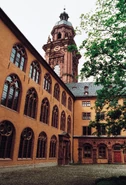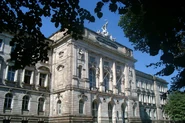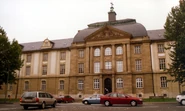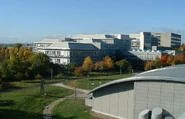| Main | Births etc |
|---|
| Würzburg | |
|---|---|
| Fortress Marienberg with Old Main Bridge in the front | |
| Country | Germany |
| State | Bavaria |
| Admin. region | Lower Franconia |
| District | Urban district |
| Founded | |
| First mentioned | |
| Government | |
| • Mayor | Christian Schuchardt (CSU) |
| Area | |
| • Total | 87.63 km2 (33.83 sq mi) |
| Elevation | 177 m (581 ft) |
| Population (2010-12-31)[1] | |
| • Total | 133,799 |
| • Density | 1,500/km2 (4,000/sq mi) |
| Time zone | CET/CEST (UTC+1/+2) |
| Postal codes | 97018–97084 |
| Dialling codes | 0931 |
| Vehicle registration | WÜ |
Cathedral and city hall.
Würzburg Residence
Würzburg (German pronunciation: [ˈvʏɐ̯tsbʊɐ̯k]; Main-Franconian: Wörtzburch) is a city in the region of Franconia, Northern Bavaria, Germany. Located on the Main River, it is the capital of the Regierungsbezirk Lower Franconia. The regional dialect is Franconian.
Würzburg lies at about equal distance (120 kilometer, or 75 miles) between Frankfurt am Main and Nuremberg. Although the city of Würzburg is not part of the Landkreis Würzburg, i.e. the county or district of Würzburg, it is the seat of the district's administration. The city's population is 133,501 as of 31 December 2008.
History[]
Early and medieval history[]
Impression of the city seal of 1319
Woodcut depicting Würzburg from the Nuremberg Chronicle (1493)
A Bronze Age (Urnfield culture) refuge castle stood on the site of the present Fortress Marienberg. The former Celtic territory was settled by the Alamanni in the 4th or 5th century, and by the Franks in the 6th to 7th. Würzburg was a Merovingian seat from about 650, Christianized in 686 by Irish missionaries Kilian, Kolonat and Totnan. The city is mentioned in a donation by Hedan II to bishop Willibrord, dated 1 May 704, in castellum Virteburch. The Ravenna Cosmography lists the city as Uburzis at about the same time.[2] The name is presumably of Celtic origin, but based on a folk etymological connection to the German word Würze "herb, spice", the name was Latinized as Herbipolis in the medieval period.[3] Beginning in 1237, the city seal depicted the cathedral and a portrait of Saint Kilian, with the inscription SIGILLVM CIVITATIS HERBIPOLENSIS.
The first diocese was founded by Saint Boniface in 742 when he appointed the first bishop of Würzburg, Saint Burkhard. The bishops eventually created a duchy with its center in the city, which extended in the 12th century to Eastern Franconia. The city was the seat of several Imperial Diets, including the one of 1180, in which Henry the Lion was banned from the Empire and his duchy was handed over to Otto of Wittelsbach. Massacres of Jews took place in 1147 and 1298.
The first church on the site of the present Würzburg Cathedral was built as early as 788, and consecrated that same year by Charlemagne; the current building was constructed from 1040 to 1225 in Romanesque style. The University of Würzburg was founded in 1402 and re-founded in 1582. The citizens of the city revolted several times against the prince-bishop, until decisively defeated in 1400.
It shows a banner on a tilted lance, formerly in a blue field, with the banner quarterly argent and gules (1532), later or and gules (1550). This coat of arms replaced the older seal of the city, showing Saint Kilian, from 1570.[4]
The Würzburg witch trials, which occurred between 1626 and 1631, are one of the largest peace-time mass trials. In Würzburg, under Bishop Philip Adolf an estimated number between six hundred and nine hundred witches were burnt.[5] In 1631, Swedish King Gustaf Adolf invaded the town and destroyed the castle. In 1720, the foundations of the Würzburg Residence were laid. The city passed to the Electorate of Bavaria in 1803, but two years later, in the course of the Napoleonic Wars, it became the seat of the Electorate of Würzburg, the later Grand Duchy of Würzburg. In 1814, the town became part of the Kingdom of Bavaria and a new bishopric was created seven years later, as the former one had been secularized in 1803 (see also Reichsdeputationshauptschluss).
Modern history[]
In 1817, Friedrich Koenig and Andreas Bauer founded 'Schnellpressenfabrik Koenig & Bauer' (the oldest printing press manufacturer in the world).
On 16 March 1945, about 90% of the city full of civilians (and military hospitals) was destroyed in 17 minutes by 225 British Lancaster bombers during a World War II air raid. All of the city's churches, cathedrals, and other monuments were heavily damaged or destroyed. The city center, which dated from medieval times, was totally destroyed in a firestorm in which 5,000 people perished.
Over the next 20 years, the buildings of historical importance were painstakingly and accurately replicated. The citizens who rebuilt the city immediately after the end of the war were mostly women – Trümmerfrauen ("rubble women") – because the men were either dead or taken prisoner of war. In comparison, Würzburg was destroyed to a larger extent than was Dresden in a firebombing the previous month.
On April 3, 1945, Würzburg was attacked by the US 12th Armored Division and US 42nd Infantry Division in a series of frontal assaults masked by smokescreens. The battle continued until the final German resistance was defeated 5 April 1945.[6][7]
After the war, Würzburg was host to the U.S. Army's 3rd Infantry Division, 1st Infantry Division, U.S. Army Hospital and various other U.S. military units that maintained a presence in Germany. The U.S. units were withdrawn from Würzburg in 2008, bringing an end to over 60 years of U.S. military presence in Würzburg.
Würzburg is home of the oldest Pizzeria in Germany. Nick di Camillo opened his restaurant named "Bier- und Speisewirtschaft Capri" on 24 March 1952. Mr Camillo received the honor of the Italian Order of Merit.
City structure[]
Würzburg is divided into 13 municipals which are additionally structured 25 boroughs. In the following overview, the boroughs and their numbers are allocated to the 13 municipals.
|
01 Altstadt
|
02 Zellerau
03 Dürrbachtal
04 Grombühl
05 Lindleinsmühle
|
06 Frauenland
07 Sanderau
08 Heidingsfeld
09 Heuchelhof
|
10 Steinbachtal
11 Versbach
12 Lengfeld
13 Rottenbauer
|
- 14 Veitshöchheim
Main sights[]
Residenz (front view).
Notable artists who lived in Würzburg include poet Walther von der Vogelweide (12th and 13th centuries), philosopher Albertus Magnus and painter Mathias Grünewald. Sculptor Tilman Riemenschneider (1460–1531) served as mayor and participated in the German Peasants' War. The Baroque architect Balthasar Neumann (1687–1753) was one builder of the Würzburg Residence, a UNESCO World Heritage Site. Giovanni Battista Tiepolo and his son, Domenico decorated the interior of the palace, most notably the grand staircase.
Some of the city's "100 churches" survived intact. In style they range from Romanesque (Würzburg Cathedral), Gothic (Marienkapelle), Renaissance (Neubaukirche), Baroque (Stift Haug Kirche) to modern (St Andreas).
Museums of note are the Mainfranken Museum, which houses artifacts from prehistoric to modern times, as well as the Cathedral Museum, and the "Kulturspeicher", dedicated to modern classics and contemporary art, which opened in 2002. Major festivals include the Afrika Festival in May, the Mozart Festival in June/July and the Kiliani Volksfest mid July.
- Würzburg Residenz: The vast compound near the center of the town was commissioned by two prince-bishops, the brothers Johann Philipp Franz and Friedrich Karl von Schönborn. Several architects, including Johann Lukas von Hildebrandt and Maximilian von Welsch, supervised the construction between 1720 and 1744, but it is mainly associated with the name of Balthasar Neumann, the creator of its famous Baroque staircase. The palace suffered severe damage during World War II, but has been completely rebuilt. The main attractions are:
- Hofkirche: The church interior is richly decorated with paintings, sculptures and stucco ornaments. The altars were painted by Giovanni Battista Tiepolo.
- Treppenhaus: Here Giovanni Battista Tiepolo created the largest fresco in the world, which adorns the vault over the staircase designed by Balthasar Neumann. A Deutschmark bill used to depict the staircase.
- Kaisersaal: The "Emperor's Hall," the centerpiece of the palace, testifies to the close relationship between Würzburg and the Holy Roman Empire.
Fortress Marienberg
- The Marienberg Fortress is the castle on a hill across the Old Main Bridge, overlooking the whole town area as well as the surrounding hills.
- Würzburg's Old Main Bridge (Alte Mainbrücke) was built 1473–1543 to replace the destroyed Romanesque bridge that had dated from 1133. In two phases, beginning in 1730, the bridge was adorned with statues of saints and historically relevant figures. The bridge shows similarities to the Charles Bridge in Prague.
- Among Würzburg's many notable churches are the Käppele, a small Baroque/Rococo chapel by Balthasar Neumann, perched on a hill facing the fortress, and the Dom (Würzburg Cathedral). The Baroque Schönborn Chapel, a side-chapel of the cathedral, has interior decoration made of (artificial) human bones and skulls. Also in the cathedral are two of Tilman Riemenschneider's most famous works, the tomb stones of Rudolf II von Scherenberg (1466–1495) and Lorenz von Bibra (1495–1519). You can find replicas of the statues of Adam and Eve by Riemenschneider at the entrance to the Marienkapelle (on the market square). The Neumünster is a Romanesque minster church with a Baroque façade and dome. Among the Baroque churches in center of the city are Stift Haug, St. Michael, St. Stephan and St. Peter.
- The Julius Spital is a Baroque hospital with a courtyard and a church built by the prince bishop Julius Echter. The Julius Spital medieval wine cellar, together with those of the Würzburg Residence and the Bürgerspital are as picturesque as historically significant places to taste the local Frankenwein. The Julius Spital is the second largest winery in Germany, growing wine on 1.68 square kilometres (1 square mile).
- The Haus zum Falken next to the Marienkapelle, with its splendid façade, is an achievement of the Würzburg rococo period. Today, it houses the tourist information office.
- The Stift Haug was built in the years 1670–1691 as the first Baroque church in Franconia. It is the most important building of the Italian architect Antonio Petrini.
- The Würzburger Stein vineyard just outside the city is one of Germany's oldest and largest vineyards.
Education and research[]
Würzburg has many internationally recognized institutions in science and research:
University[]
The University of Würzburg (official name Julius-Maximilians-Universität Würzburg) was founded in 1402 and is one of the oldest and most traditional universities in Germany.
Academic disciplines are astronomy, biology, Catholic theology, chemistry, computer science, culture, economics, educational and social sciences, geography, history, languages and linguistics, law, literature, mathematics, medicine (human medicine, dentistry and biomedicine), pharmacy, philosophy, physics, political science, psychology and sociology.The ten faculties are spread throughout the city.
Today the university enrolls approximately 22,000 students, out of which more than 1,000 come from other countries.
- Wilhelm Röntgen's original laboratory, where he discovered X-rays in 1895, is at the University of Würzburg.
- The University awarded Alexander Graham Bell an honorary Ph.D for his pioneering scientific work.
- The Botanischer Garten der Universität Würzburg is the university's botanical garden.
University of Applied Science[]
University of applied science main building in the city centre
The University of Applied Sciences Würzburg-Schweinfurt was founded in 1971 as institute of technology with departments in Würzburg and Schweinfurt. Academic disciplines are architecture, business economics, business informatics, civil engineering, computational engineering, computer science, electrical engineering, engineering management, geodesy, graphic design, logistics, mechanical engineering, media, nursing theory, plastics engineering, social work.
With nearly 8,000 students it is the second largest university of applied science in Franconia.
Conservatory[]
The Conservatory of Würzburg is an institution with a long tradition as well as an impressive success story of more than 200 years. It was founded in 1797 as Collegium musicum academicum and is Germany’s oldest conservatory. Nowadays it's called University of Music Würzburg. After the commutation from conservatory to university of music in the early 1970s, science and research appeared to complement music education.
Fraunhofer Institute for Silicate Research[]
The Fraunhofer ISC in Würzburg is part of the Fraunhofer Society, Europe’s largest application-oriented research organization. It develops innovative materials for tomorrow’s products, offering competent, experienced and reliable partnerships to small and medium-sized enterprises and to large-scale industrial companies.
Commerce and business[]
Würzburg is mainly known as an administrative center. Its largest employers are the Julius-Maximilians-University which is one of the oldest universities in Germany, first founded in 1402 and the municipality. The largest private employers are Brose Automotive parts followed by world market leader Koenig & Bauer, a maker of printing machines. Würzburg is also the capital of the German wine region Franconia which is famous for its mineralic dry white wines especially from the Silvaner grape. Würzburger Hofbräu brewery is also producing a popular pilsner beer known worldwide.
Culture[]
Museums and galleries[]
Kulturspeicher at night.
Black-figure Etruscan amphora in the Martin-von-Wagner-Museum.
- The Mainfränkisches Museum is home to the world’s biggest collection of works by Tilman Riemenschneider. In a space of 5,400 m2 (58,125 sq ft), art by regional artists is exhibited. Exhibitions include the pre-historic collection, artifacts of the Franconian wine culture and the anthropological collection with traditional costumes.
- Fürstenbau-Museum. The restored “Fürstenbau” (prince bishop residence) of the Fortress “Marienberg” houses not only the renovated living quarters, but also the city history department of the Mainfränkisches Museum. Worth taking in are the gold jewelry and collection of liturgical vestments. Of special interest are two models of the city: Würzburg in 1525 and Würzburg in 1945.
- Museum im Kulturspeicher, housed in a historic grain storage building combined with modern architecture. Collections include the “Peter C. Ruppert" collection, with European Concrete Art after 1945 from artists such as Max Bill and Victor Vasarely; works from the Age of Romanticism, the Biedermeier period, Impressionism, Expressionism as well as contemporary, all this in more than 3,500 m² of exhibit space.
- Museum at the Cathedral, opened in 2003. It features about 700 art pieces from the last 1000 years. The 1800m2 exhibit contrasts contemporary art with older works.
- Shalom Europe, a Jewish museum. Built around 1504 tombstones discovered and excavated in the old city, the museum uses modern information technology to portray present and traditional Jewish lifestyle and survival over the past 900 years in Würzburg.
- Martin von Wagner Museum, with objects from ancient Egypt, Greece, and Rome. It is housed in the South wing of the Residenz and houses ancient marble statues and burial objects. There are also ten exhibition halls with art from the 14th to the 19th centuries.
- Siebold-Museum, which houses permanent and travelling exhibits, including the estate of the 19th-century local physician and Japan researcher Philipp Franz von Siebold.[8]
Transport[]
Roads[]
The city is located on the intersection of the Autobahns A 3 and A 7.
Rail[]
The city's main station is at the southern end of the Hanover-Würzburg high-speed rail line and offers frequent InterCityExpress and InterCity connections to cities such as Frankfurt, Nuremberg, Munich, Kassel, Hanover or Hamburg. It also is an important hub in the regional rail network.
Würzburg Main station
| Long distance | Route | |
|---|---|---|
| ICE (Linie 25) |
Munich – Nuremberg – Würzburg – Kassel – Hanover – Hamburg | |
| Munich – Augsburg – Würzburg – Kassel – Hanover – Hamburg / – Bremen | ||
| ICE (Linie 31) |
Vienna – Linz – Passau – Nuremberg – Würzburg – Frankfurt (Main) – Mainz – Koblenz – Cologne – Wuppertal – Hagen – Dortmund | |
| ICE (Linie 41) |
Munich – Nuremberg – Würzburg – Frankfurt (Main) – Cologne – Düsseldorf – Essen | |
high-speed rail line Würzburg – Hanover
| regional | Route | |
|---|---|---|
| Regional-Express | Würzburg – Kitzingen – Neustadt (Aisch) – Fürth – Nuremberg | |
| Regional-Express | Würzburg – Aschaffenburg – Hanau – Frankfurt (Main) | |
| Regional-Express | Würzburg – Osterburken – Heilbronn – Ludwigsburg – Stuttgart | |
| Regional-Express | Würzburg – Schweinfurt – Bamberg – Lichtenfels – Hof/–Bayreuth | |
| Regional-Express | Würzburg – Bamberg – Erlangen – Fürth – Nuremberg | |
| Regional-Express | Würzburg – Schweinfurt – Bad Kissingen / – Münnerstadt – Bad Neustadt – Mellrichstadt – Meiningen – Suhl – Arnstadt – Erfurt | |
| Regional train | Schlüchtern – Jossa – Gemünden (Main) – Würzburg – Schweinfurt – Bamberg | |
| Regional train | Karlstadt – Würzburg– Steinach – Ansbach – Treuchtlingen | |
| Regional train | Würzburg – Kitzingen | |
| Regional train | Würzburg – Bad Mergentheim – Weikersheim – Crailsheim | |
Trams[]
Würzburg tram crosses the River Main on the Lion Bridge (Löwenbrücke)
Würzburg has a tram network of 5 lines with a length of 19.7 kilometres (12.2 miles).
| Line | Route | Time | Stops |
|---|---|---|---|
| 1 | Grombühl – Sanderau | 20 minutes | 20 |
| 2 | Hauptbahnhof (Main station) – Zellerau | 14 minutes | 11 |
| 3 | Hauptbahnhof (Main Station) – Heuchelhof | 27 minutes | 20 |
| 4 | Sanderau – Zellerau | 23 min. | 18 |
| 5 | Grombühl – Rottenbauer | 39 minutes | 31 |
The new Line 6 from Hauptbahnhof (Main Station) to Hubland university campus via Residence will be realized in 2015.
Buses[]
27 bus lines are connecting several parts of the city and inner suburbs. 25 bus lines connect the Würzburg district with the city.
Port[]
The Main river flows into the Rhine and is connected to the Danube via the Rhine-Main-Danube Canal. This makes it part of a trans-European waterway connecting the North Sea to the Black Sea.
Bicycle[]
Designated bicycle paths are located throughout the city and the Main-Radweg bicycle trail passes through the altstadt.
Points of interest[]
- Museum im Kulturspeicher Würzburg, the municipal art museum
Notable natives and residents[]
Werner Heisenberg
Thomas Bach
- Alfred Jodl, general during World War II
- Fritz Bayerlein, World War II general
- Björn Emmerling, Field hockey player
- Cage Kennylz, American hip-hop artist
- Dirk Nowitzki, NBA Champion, currently playing for the Dallas Mavericks
- Emy Roeder, (1890-1971), expressionist sculptress and artist
- Ernst Mayr, Evolutionary biologist, most famous for the biological species concept, and his contributions to Modern evolutionary synthesis
- Frank Baumann
- Franz Oberthür (1745–1831), theologisn
- Gottfried Feder (1883-1941), economist, anti-capitalist and national socialist
- Johann Balthasar Neumann (1687–1753), military engineer and architect
- Julius Echter von Mespelbrunn (1545–1617), long-serving Prince-Bishop of Würzburg and leader Counter Reformation
- Leonhard Frank, expressionist writer
- Lorenz von Bibra, Prince-Bishop of Würzburg from 1495 to 1519
- Luitpold, Prince Regent of Bavaria was born in 1821.
- Mark Bloch, American artist, born on U.S. Military base in Würzburg in 1956
- Oskar Dirlewanger, war criminal and S.S. leader of the SS-Sturmbrigade Dirlewanger.
- Philipp Franz von Siebold, among the first Westerners to visit and work in Japan
- Philipp Stöhr (1849-1911), anatomist
- Shane Primm, Mixed martial arts fighter
- Thomas Bach, Olympic Medalist & IOC President
- Tilman Riemenschneider, artist (c. 1460–1531)
- Waltraud Meier, opera singer
- Werner Heisenberg, (1901–76) theoretical physicist, best known for asserting the uncertainty principle of quantum theory
- Wilhelm Conrad Röntgen, who discovered X-rays
- Yehuda Amichai ("Ludwig Pfeuffer"; 1924–2000), Israeli poet
International relations[]
Twin towns – Sister cities[]
Würzburg is twinned with:
Associated:
Faribault, U.S., since 1949
Nagasaki, Japan, since 2013
See also[]
- Bishopric of Würzburg
References[]
- Notes
- ^ "Fortschreibung des Bevölkerungsstandes" (in German). Bayerisches Landesamt für Statistik und Datenverarbeitung. 31 December 2010. https://www.statistikdaten.bayern.de/genesis/online?language=de&sequenz=tabelleErgebnis&selectionname=12411-009r&sachmerkmal=QUASTI&sachschluessel=SQUART04&startjahr=2010&endjahr=2010.
- ^ Norbert Wagner, 'Uburzis-Wirziburg "Würzburg"'
- ^ Heinz Willner, Der Name Würzburg, Frankenland 1/1999.
- ^ Stephanie Heyl, Stadt Würzburg (Haus der Bayerischen Geschichte). c.f. Siebmachers Wappenbuch (1605), plate 9.
- ^ Wolfgang Behringer, Witchcraft in Bavaria: Popular Magik, Religious Zealotry, and Reason of State in Early Modern Europe, (Cambridge University Press, 1997. Much info given on this in footnote 38.
- ^ Stanton, Shelby, World War II Order of Battle: An Encyclopedic Reference to U.S. Army Ground Forces from Battalion through Division, 1939–1946 (Revised Edition, 2006), Stackpole Books, p. 65, 129.
- ^ Seite 777, see also Chapter XVIII
- ^ http://würzburg.de/en/tourismandconventions/worthseeing/museums/index.html City of Würzburg – Our museums
- ^ "National Commission for Decentralised cooperation" (in French). Délégation pour l’Action Extérieure des Collectivités Territoriales (Ministère des Affaires étrangères). http://www.cncd.fr/frontoffice/bdd-region.asp?action=getRegion&id=4#tabs3. Retrieved 2013-12-26.
- Further reading
- Congress – Tourismus – Wirtschaft (A municipal enterprise of the City of Würzburg): Würzburg. Visitors' Guide. Würzburg 2007. A leaflet.
External links[]
- City of Würzburg
- "Würzburg". Encyclopædia Britannica (11th ed.). 1911.
- The Story of the Jewish Community in Würzburg - in Yad Vashem website
| ||||||||||||||||
| This page uses content from the English language Wikipedia. The original content was at Würzburg. The list of authors can be seen in the page history. As with this Familypedia wiki, the content of Wikipedia is available under the Creative Commons License. |




